oil AUDI A3 2012 Owner´s Manual
[x] Cancel search | Manufacturer: AUDI, Model Year: 2012, Model line: A3, Model: AUDI A3 2012Pages: 280, PDF Size: 70.11 MB
Page 172 of 280
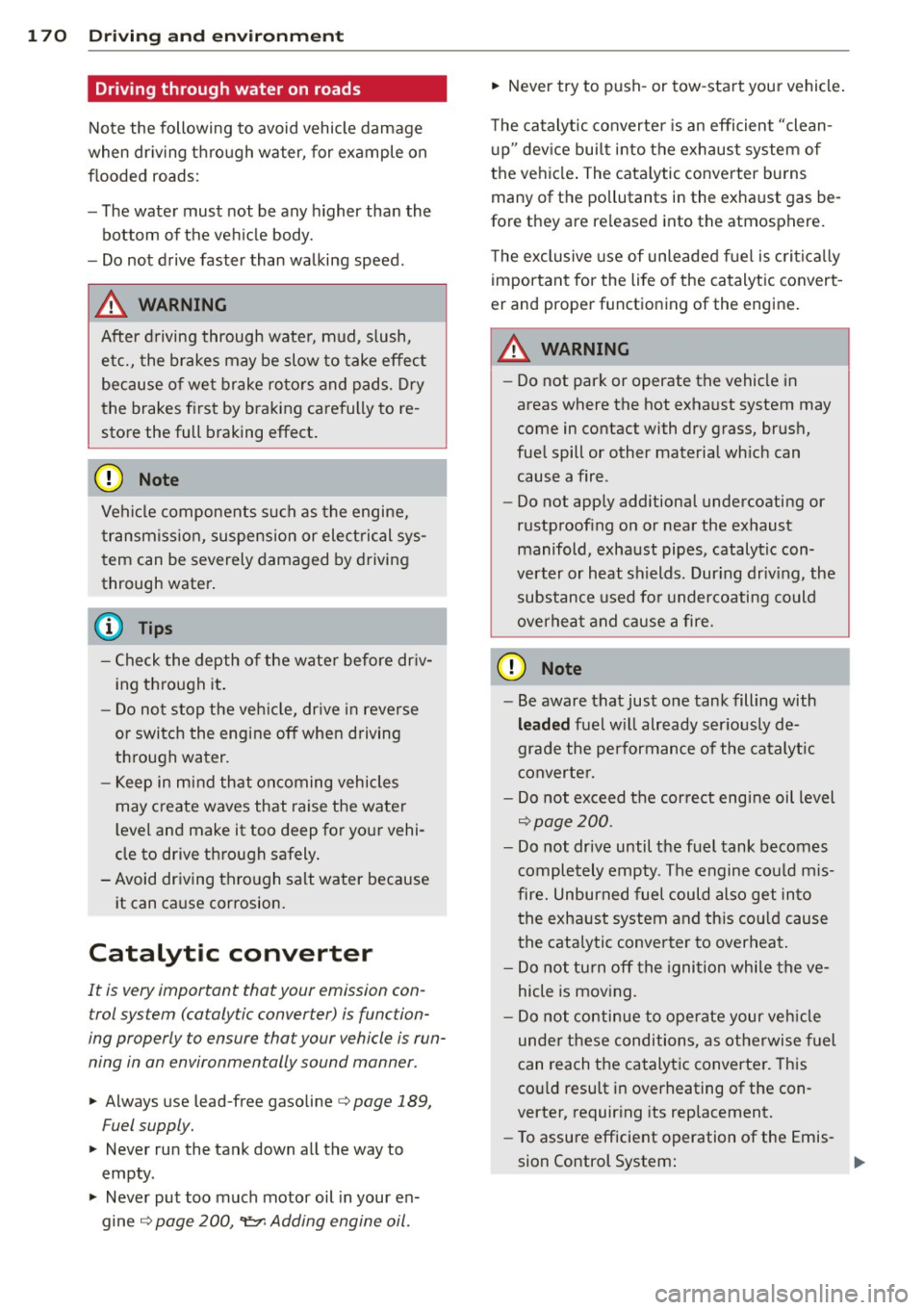
170 Driving and en vironm ent
Driving through water on roads
Note the following to avoid vehicle damage
when dr iv ing t hrough water, for example on
flooded roads:
- The water must not be any higher than the
bottom of the vehicle body.
- Do not drive faster than walking speed.
A WARNING
After d riving through wate r, mud, slush,
etc., the brakes may be slow to take effect
because o f wet brake ro tors and pads. Dry
the brakes f irst by bra king carefully to re
store the full braking effect .
({D Note
Vehicle components such as the engine,
t ransmiss ion, suspens ion or elect rical sys
tem can be severely damaged by driving
through wate r.
(D Tips
-Che ck the depth of the water before dr iv
i ng through it.
- Do no t stop the veh icle, dr ive in reverse
or switch the engine off when d riving
th rough water.
- Keep in mind that oncoming vehicles
may c reate waves that raise the wate r
l evel and make it too deep for yo ur vehi
cle to drive th rough safely .
- Avoid driving thro ugh salt water because
i t can ca use corrosion.
Catalytic converter
-
It is very important that your emission con
trol system (catalytic converter) is function
ing properly to ensure that your vehicle is run
ning in an environmentally sound manner .
"' Always use lead-free gasoline¢ page 189,
Fuel supply.
"' Never run the tank down a ll the way to
empty .
"' Never put too much motor oil in your en
gine ¢
page 200, ~ Adding engine oil .
"' Never try to push -or tow-start you r vehicle .
T he ca talytic converter is an efficient "clean
u p" dev ice bui lt into the exhaust system of
the vehicle . The cata lytic conve rter bu rns
many of the pollutants in the ex ha u st gas be
fore they are re leased into the atmosphere.
T he exclusive use of unleaded f uel is c rit ically
important for the life o f the catalyt ic convert
er and prope r function ing of the engine .
A WARNING
-Do not park or operate the vehicle in
areas where the hot exhaust system may
come in contact with dry grass, brush,
fue l spill or other material wh ich can
cause a fire .
- Do not app ly additional undercoating or
rustp roofing on or near the exhaust
manifold, exhaust pipes, catalytic con
verter or heat shields. Dur ing driv ing, the
substance used fo r under coating could
overhe at and cause a fire.
((0 Note
-Be aware that just one tank filling with
leaded fuel w ill alr eady ser iously de
grade the performance of the catalytic
converte r.
- Do not exceed t he cor rect engine oil level
¢page 200.
-Do not dr ive until t he fuel tank becomes
completely empty. The engine cou ld mis
fire. Unburned fuel could also get in to
the exhaust system and th is co uld cause
t he catalytic converter to overheat .
- Do not tu rn off the igni tion while the ve
hicle is mov ing.
- Do not continue to ope rate your veh icle
under these conditions, as ot herwise fuel
can reach the catalytic converter. This
cou ld resu lt in overheating of the con
verter, requir ing its replacement.
- To assu re efficient operation of the Emis -
sion Control System : ..,.
Page 174 of 280
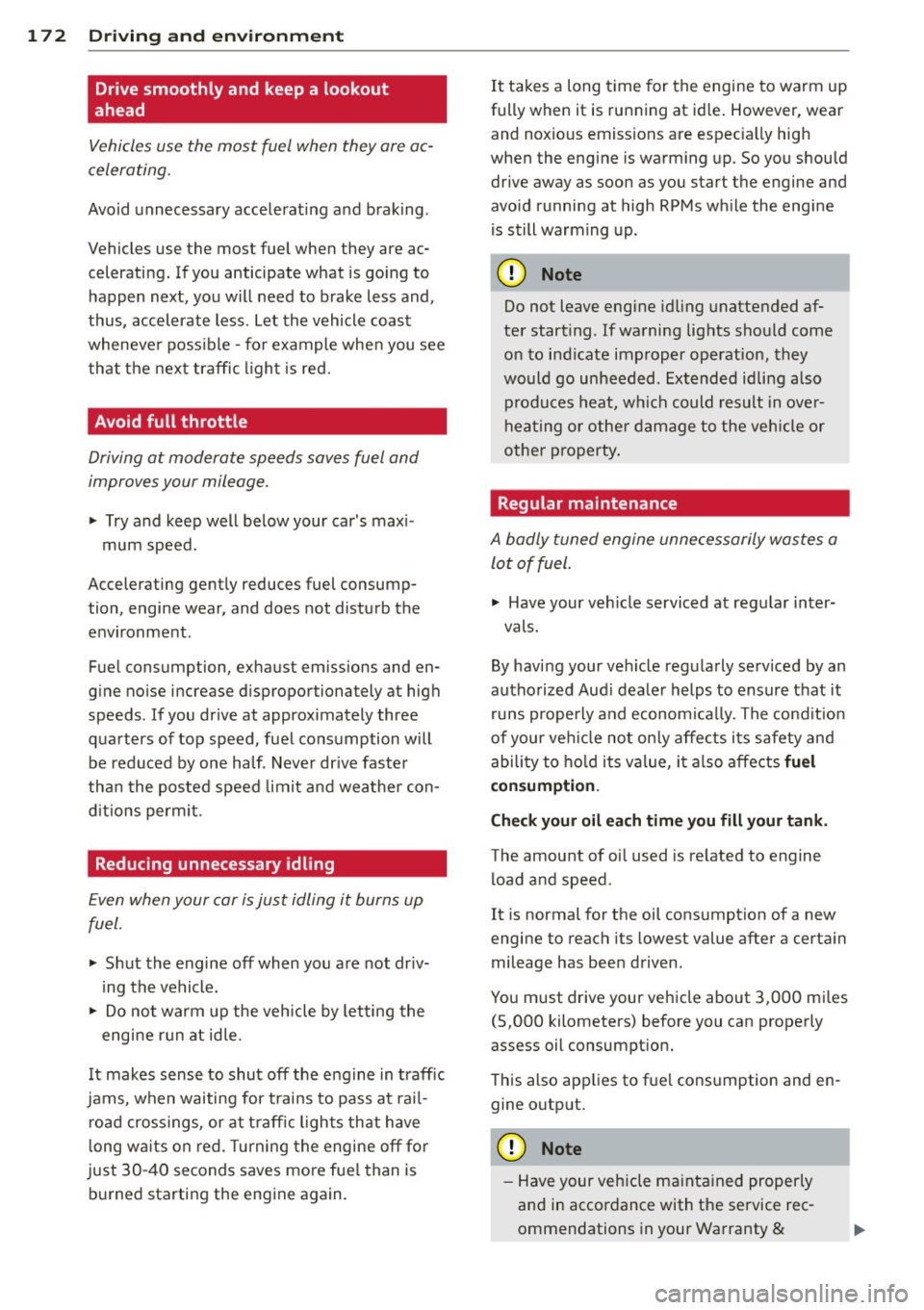
172 Driving and en vironm ent
Drive smoothly and keep a lookout
ahead
Vehicles use the most fuel when they are ac
celerating.
Avoid unnecessary accelerating and braking .
Vehicles use the most fuel when they are ac
celerati ng. If you anticipate what is go ing to
happen next, you will need to brake less and,
thus , accelerate less . let the vehicle coast
whenever poss ible -fo r example whe n you see
th at the next traffic ligh t is red.
Avoid full throttle
Driving at moderate speeds saves fuel and
improves your mileage.
,. Try and keep well be low your car's max i-
mum speed .
Accelerating gently reduces fuel consump
tion, engine wear, and does not disturb the
env ironment.
Fuel consumption, ex ha ust em issions and en
g ine no ise increase d isproportiona tely at hig h
speeds . If you dr ive at approximately three
qua rters of top speed, fuel consumption will
be reduced by one ha lf . Never dr ive faster
tha n the posted speed limit a nd weather con
d it ions permit.
Reducing unnecessary idling
E ven when your car is just idling it burns up
fuel.
,. Shut the engine off when you a re not dr iv
ing the vehicle.
,. Do not warm up the veh icle by letting the
engi ne run at idle.
It makes sense to shut off the eng ine in traff ic
jams, when waiting for trai ns to pass at ra il
road cros sings, or at t raffic ligh ts that have
l ong wa its on red. Turning the engine o ff fo r
just 30 -40 seconds saves more fue l than is
bu rne d starting the engine again.
It takes a long t ime for the engine to warm up
fully when it is running at id le . However, wea r
and noxious emissions are espec ia lly high
when the eng ine is wa rm ing up. So you shou ld
drive away as soon as yo u start the engine and
avo id running at high RPMs w hile the eng ine
i s s till warm ing up .
(D Note
Do not leave engine idling unattended af
ter start ing . If warni ng lig hts sho uld come
o n t o indicate improper ope ration, they
would go unheeded . Extended idli ng also
produ ces heat , w hich could result in ove r
hea ting or other dam age to the veh icle or
other property .
Regular maintenance
A badly tuned engine unne cessarily wastes a
lo t of fuel.
,. Have your ve hicle serviced at reg ular inter-
vals.
By havi ng your ve hicle regu larly serv iced by an
a utho rized Aud i deale r helps to ensure that it
runs properly and econom ica lly. The cond it io n
of your ve hicle not only affe cts i ts safety and
abili ty to ho ld i ts va lue , it al so a ffects
fuel
con sumption .
Check your oil each time you fill your tank .
The amount of oi l used is re lated to engine
load and speed .
It is normal for the oil consumption of a new
engine to reach its lowest value after a certa in
mileage has bee n driven .
You must drive your vehicle about 3,000 mi les
(S,000 kilometers) before you can properly
assess oil consumpt ion.
T his also app lies to fue l cons umption and en
gine o utp ut.
Q) Note
- Have your veh icle ma inta ined proper ly
and i n acco rdance with the service rec
ommendations in your Warranty
&
Page 181 of 280

CD Note
You should remove debris (such as insects)
from the headlight lenses on a regular basis, for example when refueling your vehi
cle. Never clean the headlights with a dry
cloth or sponge . Use a wet cloth or
sponge.
It is best to use soapy water .
Automatic car wash
The vehicle can be washed in almos t any
modern automatic car wash .
The vehicle paint is so durable that the vehicle
can normally be washed without problems in
an automatic car wash . However, the effect on
the paint depends to a large extent on the de
sign of the facility, the filtering of the wash
water , the type of wash and care material , etc .
If the paint has a dull appearance after going
through the car wash or is scratched, bring
this to the attention of the operator immedi
ately. If necessary, use a different car wash.
Before going through a car wash, be sure to
take the usual precautions such as closing the
windows and panoramic sliding sunroof*. Re move antenna if applicable.
If you have installed additional accessories on
the vehicle -such as spoilers, roof rack, etc. -
it is best to ask the car wash operator if these
should be removed.
A WARNING
Always read and heed all WARNINGS and other information
¢ page 178.
Washing the vehicle by hand
A lot of water is needed when washing a vehi
cle by hand.
11-Before you start washing, make sure you
have read and understood the WARNINGS
¢ A in General information on page 178.
11-First soak all dried dirt until it is soft, then
rinse it off .
11-As you clean your vehicle, s tart with the
roof and work your way down to the bottom,
Cleaning and protection 179
using a sponge, a sponge glove or a clean
brush.
"" Rinse the sponge or the sponge glove often,
flushing it clean each time.
11-Use special car shampoo only for very per
sistent dirt .
11-Rinse the car thoroughly with water .
11-Use a chamois leather to gently wipe the ex-
terior dry.
Use a separate sponge for cleaning the
wheels, door sills and other regions exposed
to road dirt. In this way, you will not scratch
the paint with coarse particles imbedded in
the sponge the next time you wash the car.
A WARNING
= -
-Do not clean the underside of the chas-
sis, fenders, wheel covers , or other hard
to reach parts without protecting your hands and arms . You may cut yourself on
sharp-edged metal parts.
- Always read and heed all WARNINGS and
other information
¢ page 178.
CD Note
- Never try to remove dirt, mud or dust if
the surface of the vehicle is dry. Never
use a dry cloth or sponge, since this
could scratch your vehicle's paint or win
dows.
- Never wash your car in bright sunlight.
Drops of water act as magnifying lenses
and may damage your paint .
- When you wash your car in the winter: if
you rinse your vehicle with a hose, be
careful not to aim the stream of water
directly at locks, or at door or hatch
openings -they can freeze shut.
- Never use sponges designed to remove
insects, or any kitchen scouring sponges
or similar products. They can damage
your paint finish.
- Never use a dry cloth or sponge to clean
the headlights. Only use wet cloths or
sponges to prevent scratches. It is best
to use soapy water. •
•
Page 183 of 280
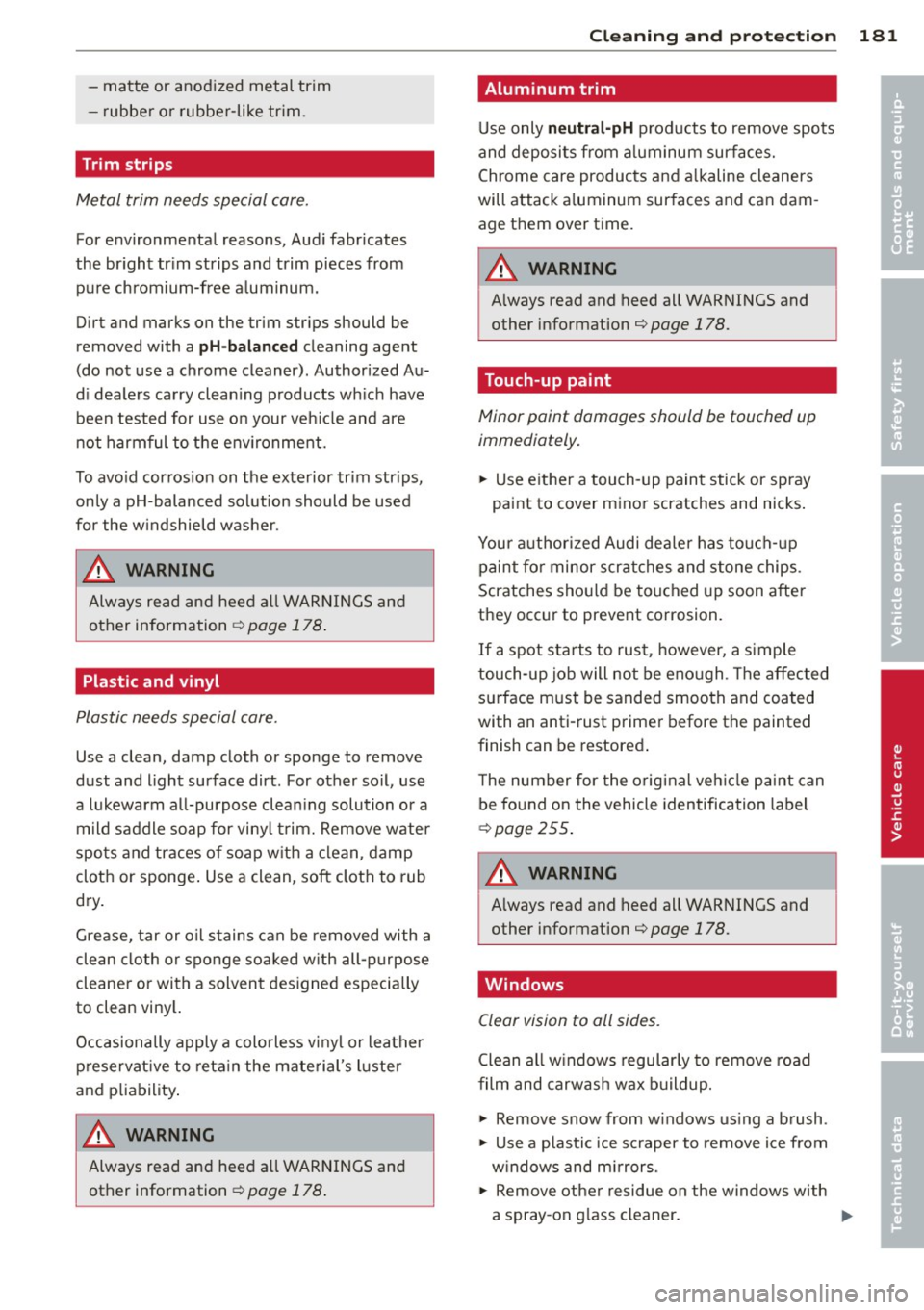
-matte or anodized metal trim
- rubber o r rubber-like tr im.
Trim strips
Metal trim needs special care.
For environmental reasons, Aud i fabricates
the br ight tr im strips and trim pieces from
pure ch romium-free a lum inum.
Dirt and marks on the trim str ips should be
removed with a pH-bal anced cleaning agent
(do not use a chrome cleaner). Authorized Au
d i dea lers carry clean ing products wh ich have
been tested for use o n your veh icle and are
not harmful to the env ironment.
To avo id corros ion on the exterior trim str ips,
on ly a pH-balanced solution should be used
for the w indshield washer.
A WARNING
Always read and heed a ll WARNINGS and
other information ¢
page 178.
Plastic and vinyl
Plastic needs special care.
Use a clean, damp cloth or sponge to remove
dust and light surface dirt. For other soil, use
a lukewarm a ll-purpose clean ing solution or a
mild saddle soap for viny l trim. Remove water
spo ts and traces o f soap w ith a clean, damp
cloth or sponge . Use a clean, soft clot h to rub
dry .
Grease, tar or o il stains can be removed with a
clean cloth or sponge soaked w ith all-p urpose
cleane r or wi th a solven t designed especially
to clean viny l.
Occasionally apply a colo rless vi nyl or leather
preservat ive to reta in the mate rial's l uste r
and pliability .
A WARNING
Always read and heed a ll WARNINGS and
other information ¢
page 178.
Cleaning and protec tion 18 1
Aluminum trim
Use only neutral- pH products to remove spo ts
and deposi ts from aluminum surfaces.
Chrome care products and a lkaline cleaners
will attack a luminum surfaces and can dam
age them over time.
A WARNING
A lways read and heed all WARNINGS and
other information ¢
page 178.
Touch-up paint
Minor paint damages should be touched up
immediately.
.. Use e ithe r a touch-up pain t stick or spray
paint to cover minor scratches and nicks .
You r authorized Audi de aler has to uch-up
paint for minor scra tches and stone chips.
Scratches sho uld be touched up soon after
they occur to prevent corrosion .
If a spot sta rts to rust, however, a s imple
touch-up job will not be eno ugh. The affected
su rface m ust be sanded smooth and coated
with an anti -rust prime r before the painted
finish can be restored .
T he number for the orig ina l veh icle pa int can
be fo und on the vehicle identification label
¢ page 255.
A WARNING
-Always read and heed all WAR NINGS and
other information
¢ page 178.
Windows
Clear vision to all sides.
Clean a ll w indows regularly to remove road
f ilm and carwash wax b uildup.
.. Remove snow from w indows us ing a b rush .
.,. Use a p lastic ice s craper to remove ice from
w indows and m irrors .
.,. Remove othe r residue on the w indows with
a spray -on g lass cleaner.
IJI>
•
•
Page 186 of 280
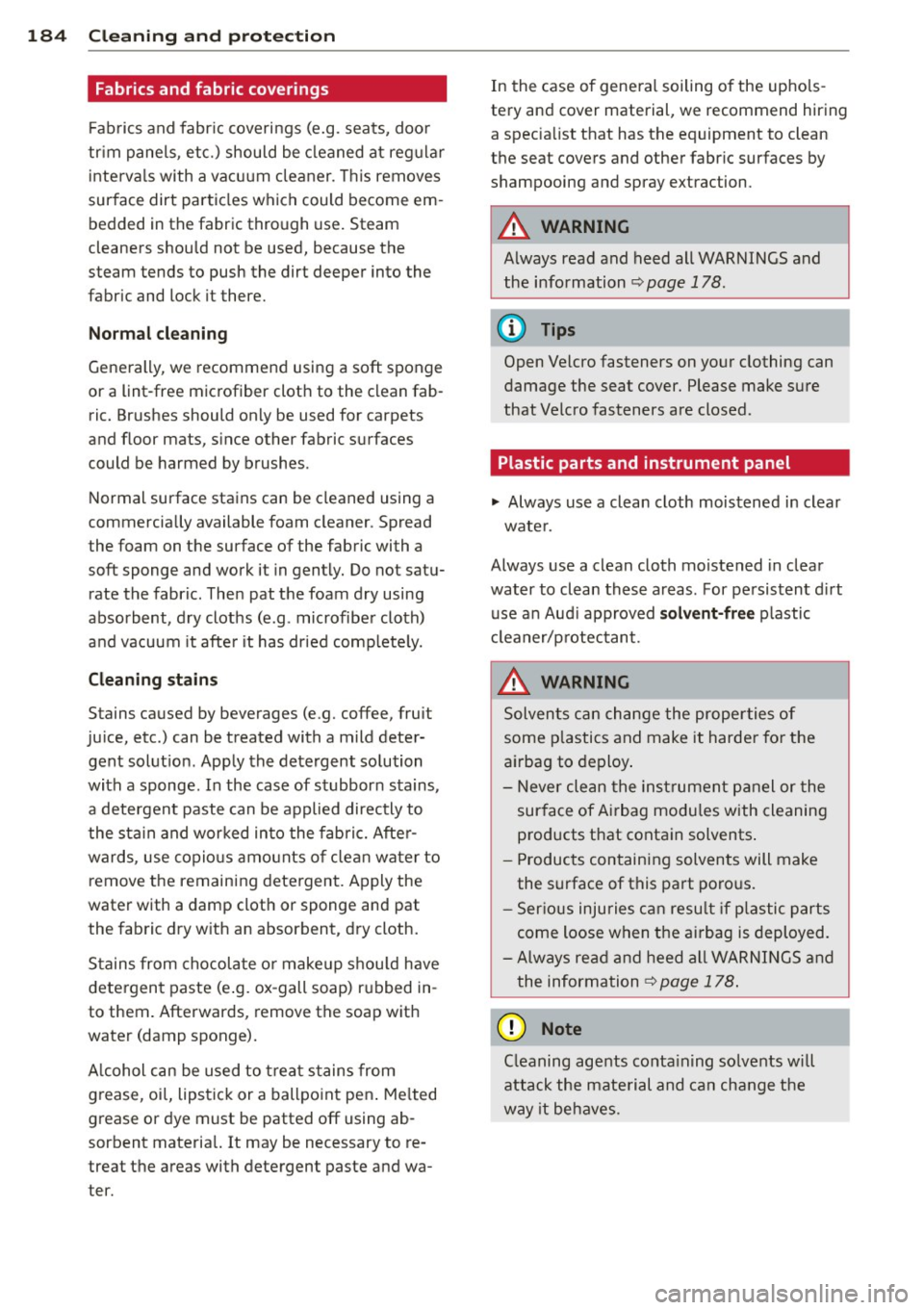
184 Cleaning and protection
Fabrics and fabric coverings
Fab rics and fabr ic coveri ngs (e.g. seats, door
tr im panels, etc.) should be cleaned at reg ular
inte rva ls with a vacuum cleaner. This removes
sur face dirt particles which could become em
bedded in the fabric through use. Steam
cleaners shou ld not be used, because the
steam tends to push the dirt deeper into the
fabric and lock it there.
Normal cleaning
Generally, we recommend using a soft sponge
or a lint-free microfiber cloth to the clean fab
ric. Brushes should on ly be used for carpets
and floor mats, s ince other fabric surfaces
could be harmed by brushes.
Normal surface stains can be cleaned using a
commercially available foam cleaner. Spread
the foam on the surface of the fabric with a
soft sponge and work it in gently. Do not satu
rate the fabric. Then pat the foam d ry using
absorbent, dry cloths (e.g . microfiber cloth)
and vacuum it afte r it has dried comp lete ly.
Cleaning stain s
Stains caused by beverages (e.g. coffee, fruit
ju ice, etc.) can be treated with a mild deter
gent solut ion. App ly the detergent so lution
with a sponge. In the case of stubbor n stains,
a detergent paste can be applied directly to
the sta in and wor ked into the fabric. Afte r
wards, use copio us amo unts o f cle an water to
remove t he remaining dete rgent. Apply the
water with a damp cloth or sponge and pat
the fabric d ry w ith an absorbent, dry cloth.
S tains from chocola te or make up s hou ld have
detergent paste (e .g. ox -gall soap) r ubbed in
to them. Afterwards, remove the soap with
water (damp sponge).
A lcohol can be used to t rea t stains from
g rease, oi l, lips tick or a ballpo in t pen . Me lted
grease or dye must be patted off using ab
sorbent materia l. It may be necessary to re
treat the areas with dete rgent paste and wa
ter. In the case of gene
ra l soiling o f the uphols
tery and cover material, we recommend hiring
a spec ia list that has the equipment to clean
the seat covers and other fabr ic surfaces by
shampooing and spray extraction.
A WARNING '"--
A lways read and heed all WARNINGS and
the information
~ page 178.
(D Tips
Open Ve lcro fasteners on yo ur clothing can
damage the seat cover. Please make sure
that Velcro fasteners are closed.
Plastic parts and instrument panel
~ Always use a clean cloth moistened in clear
wate r.
Always use a clean cloth moistened in clear
water to clean these areas. For pe rsisten t dirt
use an Aud i approved
solvent -free p lastic
cl eaner/p rotec tant.
A WARNING
S olven ts ca n ch ange the prope rties of
some p lastics and make it harde r fo r the
a ir ba g to de ploy .
-
- N ever cle an the in st rument p anel or the
sur face of Ai rbag modu les with cleaning
prod ucts t hat conta in solvents .
- P roduc ts containing solven ts will make
the surface of this part poro us.
- Ser ious inju ries c an resu lt if p lastic parts
come loose when t he ai rbag is deployed.
- Always re ad and heed a ll WAR NIN GS and
t he information¢
page 178 .
(J) Note
Cleaning agents conta ining so lvents w ill
a ttack t he mate rial and can ch ange the
w ay it behaves.
Page 187 of 280
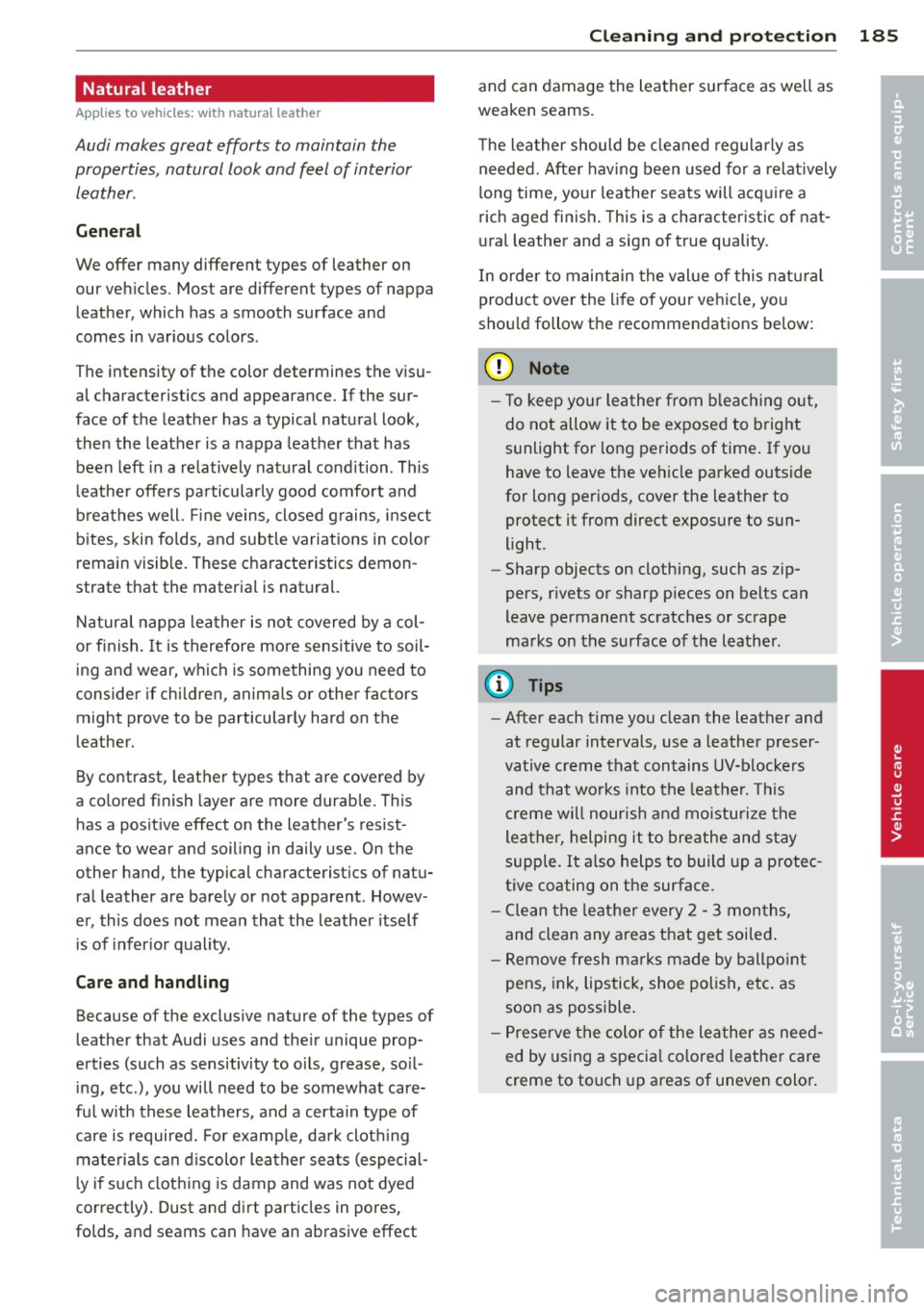
Natural leather
Appl ies to vehicles: with nat ura l leather
Audi makes great efforts to maintain the
properties , natural look and feel of interior
leather .
General
We offer many different types of leather on
our veh icles. Most are different types of nappa
leather, which has a smooth surface and
comes in var ious colors .
The intensity of the color determines the v isu
al characteristics and appearance. If the sur
face of the leather has a typical natural look,
then the leather is a nappa leather that has been left in a relatively nat ural condition . This
l eather offers pa rticularly good comfo rt and
breathes well. Fine ve ins, closed g rains, i nsect
b ites, skin folds, and subtle variations in color
remain visib le. These characteristics demon
strate that the materia l is natural.
Natural nappa leather is not covered by a col
or finish .
It is therefore more sensitive to soil
ing and wear, which is something you need to
consider if chi ldren, animals or other factors
might prove to be particularly hard on the
leather.
By contrast, leather types that are covered by
a co lored finish layer are more durable. This
has a positive effect on the leather's resist
ance to wear and soiling in daily use. On the
other hand, the typical characterist ics of natu
ral leather a re barely or not apparent . Howev
er, this does not mean that the leather itself
i s of infer ior quality.
Care and handling
Because of the exclusive nature of the types of
leather that Audi uses and the ir unique prop
erties (such as sensitivity to o ils, grease, so il
in g, etc.), you will need to be somewhat care
fu l w ith these leathers, and a certain type of
care is required. For examp le, da rk cloth ing
materials can d iscolor leather seats (especial
l y i f such clothing is damp and was not dyed
correctly) . Dust and dirt particles in pores,
fo lds, and seams can have an abrasive effect
Cleaning and protec tion 185
and can damage the leather surface as we ll as
weaken seams.
T he lea ther should be cleaned regularly as
needed. After hav ing been used for a relat ive ly
long time, your leather seats will acq uir e a
rich aged finish . This is a characteristic of nat
ural leather and a sign of true quality.
In order to maintain the val ue of this natural
product over the li fe of your vehicle, you
sho uld follow the recommendations below:
(D Note
- T o keep your lea ther from b leach ing out,
do not allow it to be exposed to bright
sunlight for long periods of time . If you
have to leave the ve hicle parked outside
for long per iods, cover the leather to
protect it from direct exposure to sun
light.
- Sharp objects on clothing, such as zip
pers, rivets or sharp pieces on belts can
leave permanent scratches or scrape
marks on the surface of the leather.
(D Tips
-After each time you clean the leather and
at regular intervals, use a leather preser
vative creme that contains UV-blockers and that works into the leathe r. T his
c reme w ill nour is h and mo istu rize the
lea ther, helping it to breathe and stay
supple.
It also helps to build up a protec
tive coating on the surface.
- C lean the leather every 2 - 3 mon ths,
and clean any areas that get soi led .
- Remove fresh m arks made by ballpo int
pens, ink, lipstick, shoe polish, etc. as
soon as possible .
- Preserve the color o f the leather as need
ed by using a specia l co lored leathe r care
creme to touch up areas of uneven color . •
•
Page 188 of 280
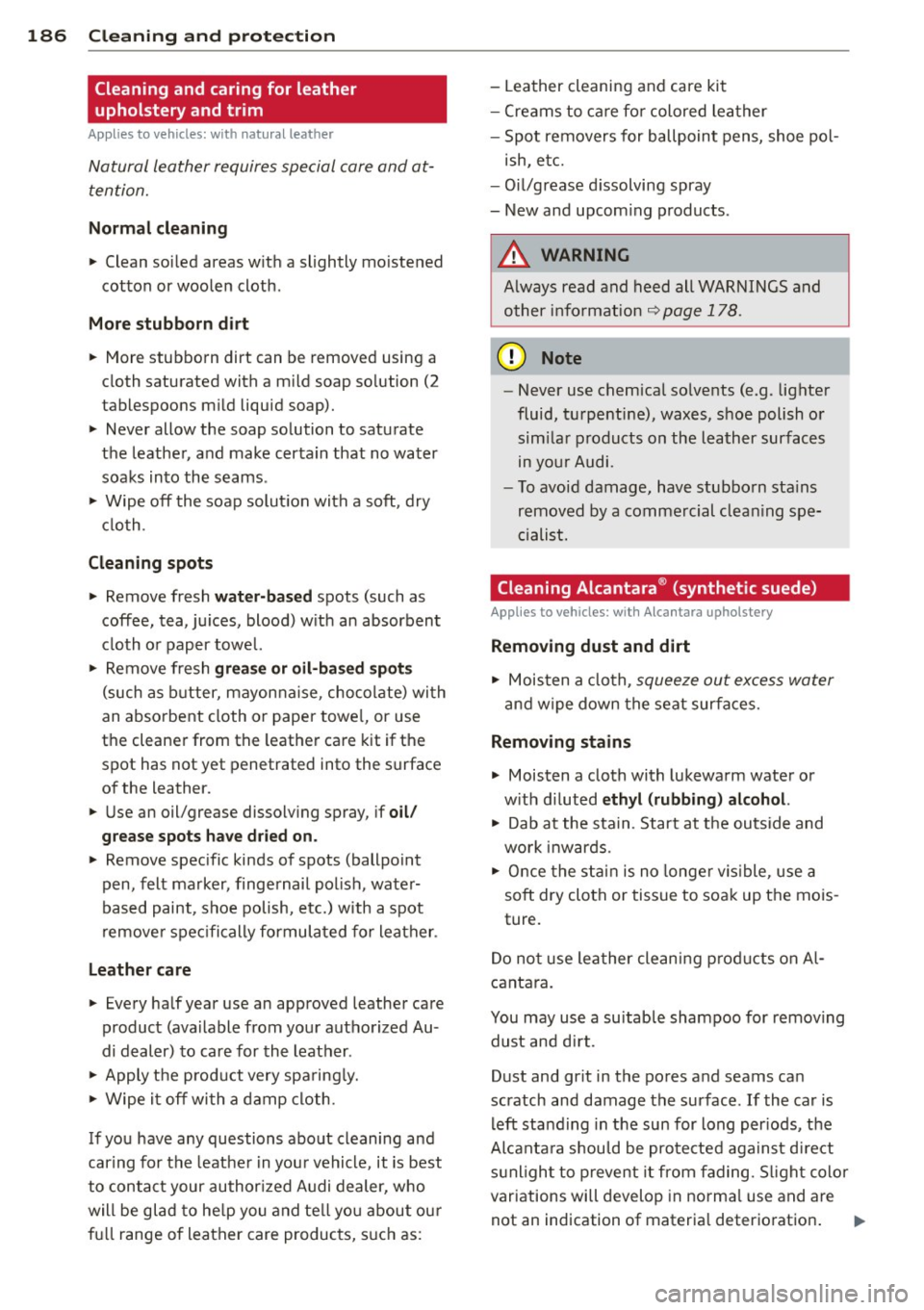
186 Cleaning and protection
Cleaning and caring for leather
upholstery and trim
Applies to vehicles: with natural leather
Natural leather requires special care and at
tention.
Normal cleaning
"' Clean soiled are as with a slightly moi stened
cotton or woolen cloth.
More stubborn dirt
"' More stubborn dirt can be removed us ing a
cloth saturated with a mild soap solution (2
tablespoons mild liquid soap).
"' Never allow the soap solution to saturate
the leather , and make certain that no water
soaks into the seams .
• Wipe off the soap solution with a soft, dry
cloth .
Cleaning spots
"' Remove fresh water-based spots (such as
coffee, tea, juices, blood) with an absorbent
cloth or paper towel.
"' Remove fresh
grease or oil-based spots
(such as butter, mayonnaise , chocolate) with
an absorbent cloth or paper towel, or use
the cleaner from the leather care kit if the
spot has not yet penetrated into the surface
of the leather.
"' Use an oil/grease dissolving spray, if
oil/
grease spots have dried on.
• Remove specific kinds of spots (ballpoint
pen, felt marker, fingernail polish, water
based paint, shoe polish, etc.) with a spot
remover specifically formulated for leather .
Leather care
"' Every half year use an approved leather care
product (available from your authorized Au
di dealer) to care for the leather .
• Apply the product
very sparingly.
• Wipe it off with a damp cloth.
If you have any questions about cleaning and
caring for the leather in your vehicle , it is best
to contact your authorized Audi dealer, who
will be glad to help you and tell you about our
full range of leather care products, such as: -
Leather cleaning and care kit
- Creams to care for colored leather
- Spot
removers for ballpoint pens, shoe pol-
ish, etc.
- Oil/grease dissolving spray
- New and upcoming products .
_&. WARNING
-Always read and heed all WARNINGS and
other information ~
page 178.
(D Note
-Never use chemical solvents (e.g . lighter
fluid, turpentine), waxes, shoe polish or similar products on the leather surfaces
in your Audi .
I
-To avoid damage, have stubborn stains
removed by a commercial cleaning spe
cialist.
Cleaning Alcantara ® (synthetic suede)
Applies to vehicles: with Alcantara upholstery
Removing dust and dirt
• Moisten a cloth , squeeze out excess water
and wipe down the seat surfaces.
Removing stains
"' Moisten a cloth with lukewarm water or
with diluted
ethyl (rubbing) alcohol.
"' Dab at the stain . Start at the outside and
work inwards .
"' Once the stain is no longer visible, use a
soft dry cloth or tissue to soak up the mois
ture.
Do not use leather cleaning products on Al
cantara.
You may use a suitable shampoo for removing dust and dirt.
Dust and grit in the pores and seams can
scratch and damage the surface. If the car is left standing in the sun for long periods, the
Alcantara should be protected against direct
sunlight to prevent it from fading. Slight color
variations will develop in normal use and are
not an indication of material deterioration.
ll-
Page 189 of 280

(D Note
- Never use chemical solvents (e.g . lighter
flu id, turpentine), waxes, shoe polish or
s imilar products on Alcantara ® surfaces.
- To avoid damage, have stubborn stains
removed by a commercia l cleaning spe
cialist.
- Do not use brushes, stiff sponges or sim
ilarly abrasive cleaning aids.
Safety belts
Only well-maintained safety belts work relia
bly when needed.
.. Keep belts clean .
.. For cleaning, use a mi ld soap and water sol
ution . Let be lts dry thoroughly and away
from direct sunlight.
.,. Do not allow inertia reel safety belts to re
tract before they are completely dry.
.,. Check the condition of your safety belts
reg
ularly .
Heavily soiled safety belts may not retract
properly .
A WARNING
Damaged safety belts can break in a crash.
- Anything that might damage your safety
belts could mean that you and your pas
sengers wou ld not be adequately pro
tected in an acc ident.
- Safety belt performance depends on cor
rect installation. Never remove belts
from the vehicle to clean them.
- Do not use chemical cleaning agents,
bleach o r dyes. They have corros ive prop
erties whi ch weaken the webbing.
- When cleaning your safety belts, inspect
them for damage.
If you discover dam
age, see your a uthorized Audi dea ler.
- Always read and heed all WARN INGS and
other information
Q page 178.
l ) Use o nly the correct cleaning sol utions. Neve r use gas
oline or d iese l fuel.
Cleaning and protec tion
Engine compartment
Be especially careful when cleaning the en
gine compartment.
A lw ays switch o ff the ign it ion before cle an
i ng the eng ine
c> ,& .
Plenum pan el
Remove leaves from the plenum panel in front
of the windshield under the engine hood. This
prevents the water drain holes from becoming
blocked, and it prevents debris from enter ing
the vehicle interior through the heating and
vent ilat ion ducts.
Co rro sio n protect ion
The engine compartment and transmission
have been corrosion-protected at the factory.
Good anti -corrosion treatment is very impor
tant, partic ularly in the winter.
If the vehicle
is frequently driven on salt treated roads, the
entire engine compartment and p lenum panel
should be thoroughly cleaned at the end of
winter and retreated to prevent salt damage.
At the same time, the underside of the vehicle
shou ld be washed as well.
If the engine compartment is cleaned at any
time with grease remov ing solutions
1> , or if
you have the engine washed, the anti-corro
s ion treatment is almost always removed as
well.
It i s therefo re essentia l to have a long
lasti ng cor rosion pro tect ion reapplied to all
surfaces, seams, joints and components in the
engine compartment .
A WARNING
Be aware: The engine compartment of any
motor vehicle is a potentially hazardous
area.
- Before work ing in the engine compart
ment, be sure to read the information
c>page 194.
- Before reaching into the front plenum
panel, a lways remove the ignit ion key.
187
•
•
Page 193 of 280
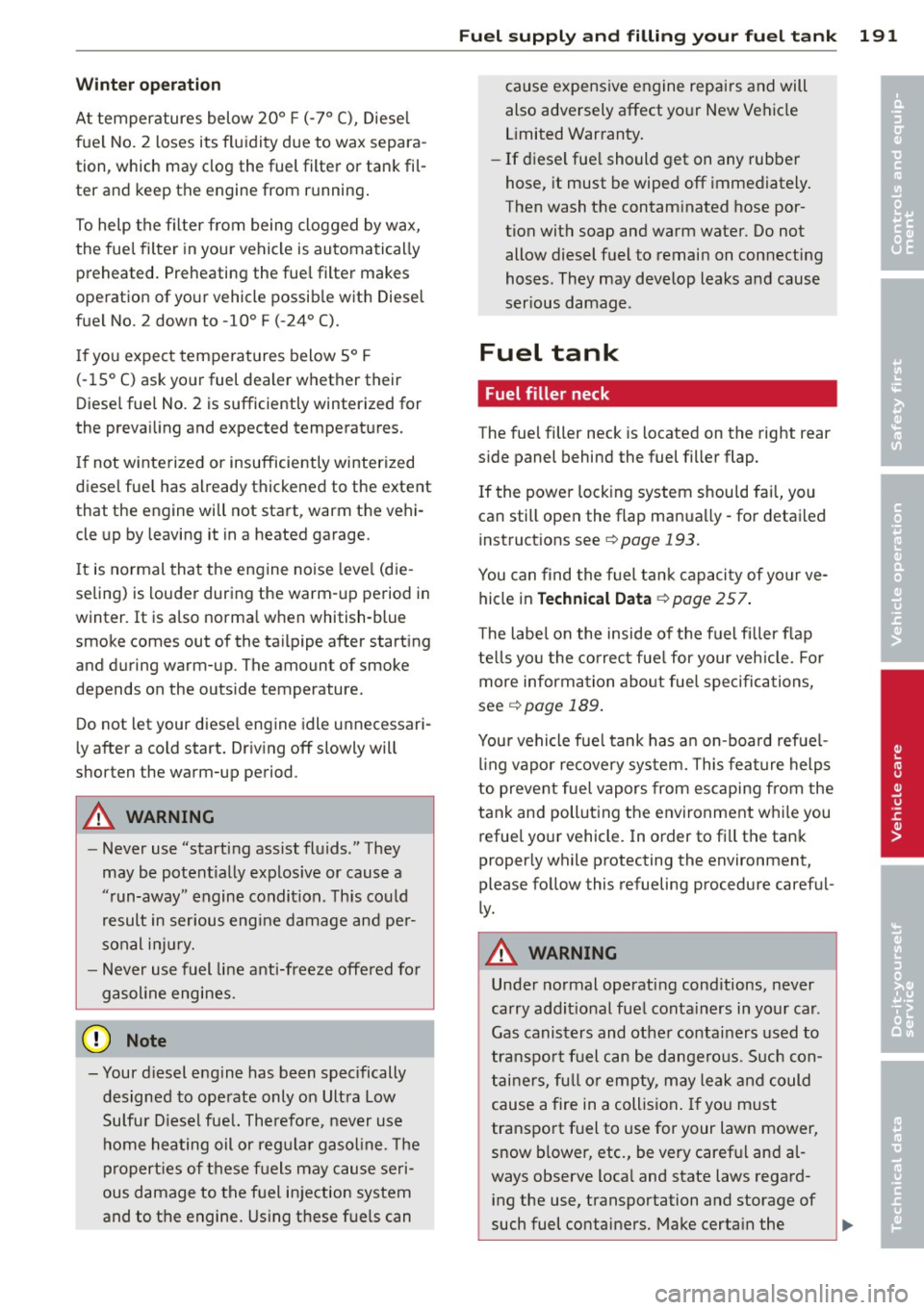
Winter operation
At temperatures below 20° F (-7° C), Diesel
fuel No.
2 loses its fluidity due to wax separa
tion, which may clog the fuel filter or tank fil
ter and keep the engine from running .
To help the filter from being clogged by wax,
the fuel filter in your vehicle is automatically
preheated. Preheating the fuel filter makes
operation of your vehicle possible with Diesel
fuel No . 2 down to -10° F (-24° C).
If you expect temperatures below
5° F
(-15° C)
ask your fuel dealer whether their
Diese l fuel No.
2 is sufficiently winterized for
the prevailing and expected temperatures.
If not winterized or insufficiently winterized
d iesel fue l has already thickened to the extent
that the engine will not start, warm the vehi
cle up by leaving it in a heated garage.
It is normal that the engine noise leve l (die
seling) is louder during the warm-up period in
winter.
It is also norma l when whitish-blue
smoke comes out of the tailpipe after start ing
and during warm-up . The amount of smoke
depends on the outs ide temperature.
Do not let your diesel engine idle unnecessari
ly after a cold start. Driving off slowly will
shorten the warm-up period .
A WARNING
-Never use "starting assist fluids." They
may be potent ially explosive or cause a
"run-away" engine condition. This could
result in serious engine damage and per
sonal injury.
- Never use fuel line anti-freeze offered for
gasoline engines .
0 Note
- Your diesel engine has been specifically
designed to operate only on Ultra Low
Sulfur Diesel fuel. Therefore, never use
home heating oil or regular gasol ine. Th e
properties of these fuels may cause seri
ous damage to the fuel injection system
and to the engine. Using these fuels can
-
Fuel supply and filling your fuel tank 191
cause expensive engine repai rs and will
also adversely affect your New Vehicle
Limited Warranty.
- If diesel fuel should get on any rubber
hose, it must be wiped off immediately.
Then wash the contaminated hose por
tion with soap and warm water. Do not
allow diesel fuel to remain on connecting
hoses. They may develop leaks and cause
ser ious damage.
Fuel tank
Fuel filler neck
The fuel filler neck is located on the right rear
side panel behind the fuel filler flap.
If the power locking system should fail, you
can still open the flap manually -for detailed
instructions see
¢ page 193.
You can find the fuel tank capacity of your ve
hicle in
Technical Data ¢page 257 .
The labe l on the inside of the fuel fi ller flap
tells you the correct fuel for your vehicle. For
more information about fuel specifications,
see
¢ page 189.
Your vehicle fuel tank has an on-board refuel
ling vapor recovery system. This feature helps
to prevent fuel vapors from escaping from the
tank and polluting the environment while you refue l your vehicle. In order to fi ll the tank
properly while protecting the environment,
please follow this refueling procedure careful
ly.
A WARNING
Under normal operating conditions, never
carry addit ional fuel conta iners in your car .
Gas canisters and other containers used to
transport fuel can be dangerous. Such con
tainers, full or empty, may leak and could
cause a fire in a collision. If you must
transport fuel to use for your lawn mower,
snow b lower, etc., be very careful and al
ways observe loca l and state laws regard
ing the use, transportation and storage of
such fuel containers. Make certain the
~
•
•
Page 197 of 280
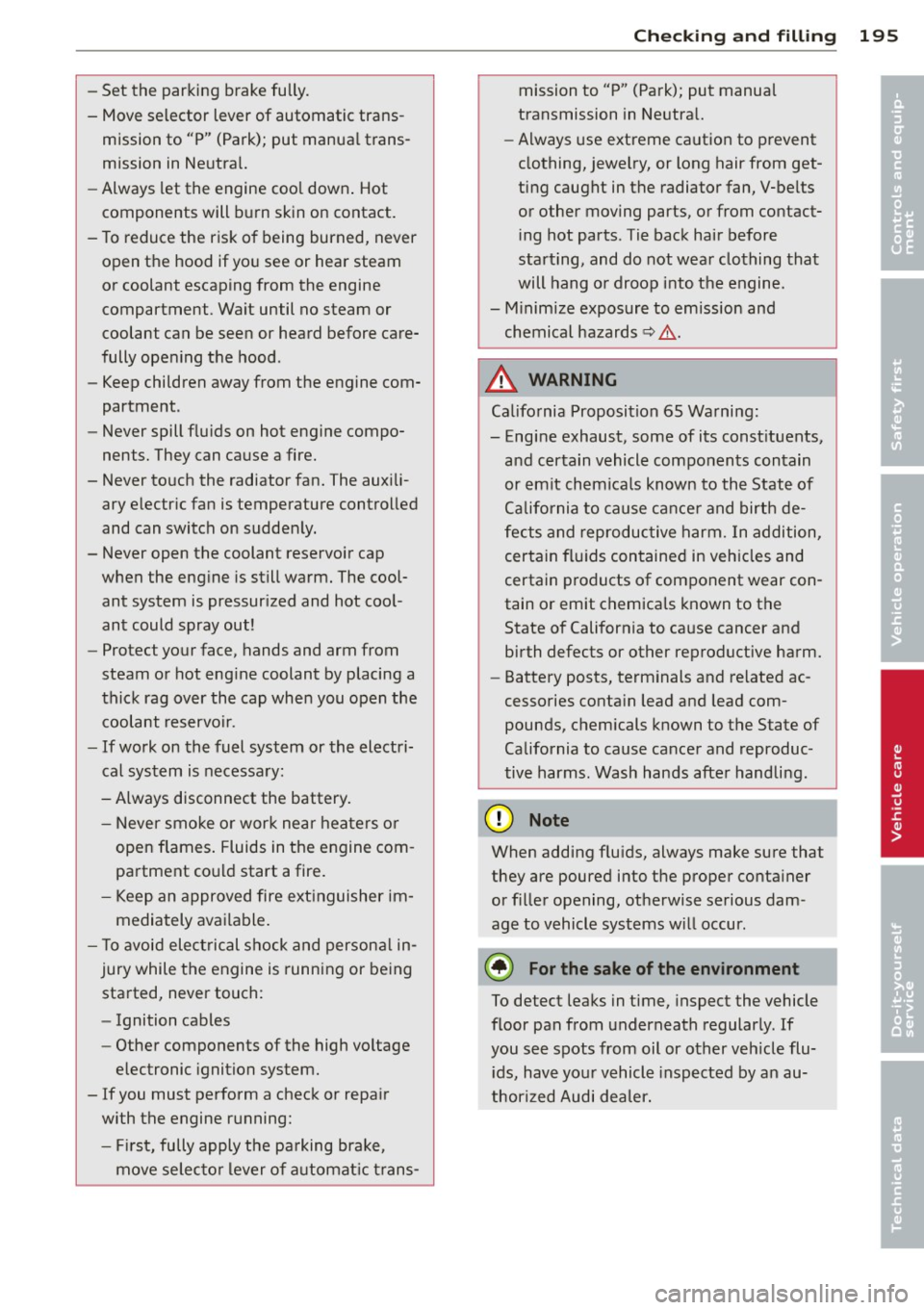
-Set the parking brake fully.
- Move selector lever of automatic trans-
mission to "P" (Park); put manual trans
mission in Neutral.
- Always let the engine cool down . Hot
components will burn skin on contact.
- To reduce the risk of being burned, never
open the hood if you see or hear steam
or coolant escaping from the engine
compartment . Wait until no steam or
coolant can be seen or heard before care
fully opening the hood .
- Keep children away from the engine com
partment .
- Never spill fluids on hot engine compo
nents. They can cause a fire.
- Never touch the radiator fan. The auxili
ary electric fan is temperature controlled
and can switch on suddenly.
- Never open the coolant reservoir cap
when the engine is still warm. The cool
ant system is pressurized and hot cool ant could spray out!
- Protect your face, hands and arm from
steam or hot engine coolant by placing a
thick rag over the cap when you open the
coolant reservoir .
- If work on the fuel system or the electri
cal system is necessary:
-Always disconnect the battery.
- Never smoke or work near heaters or
open flames. Fluids in the engine com
partment could start a fire.
- Keep an approved fire extinguisher im
mediately available.
- To avoid electrical shock and personal in
jury while the engine is running or being
started, never touch:
- Ignition cables
- Other components of the high voltage
electronic ignition system.
- If you must perform a check or repair
with the engine running:
- First, fully apply the parking brake,
move selector lever of automatic trans-
Checking and filling 195
mission to "P" (Park); put manual
transmission in Neutral.
- Always use extreme caution to prevent
clothing, jewelry, or long hair from get
ting caught in the radiator fan, V-belts
or other moving parts, or from contact
ing hot parts . Tie back hair before
starting, and do not wear clothing that
will hang or droop into the engine .
- Minimize exposure to emission and
chemical hazards~&. .
A WARNING
California Proposition 65 Warning:
- Engine exhaust, some of its constituents,
and certain vehicle components contain
or emit chemicals known to the State of
California to cause cancer and birth de
fects and reproductive harm. In addition,
certain fluids contained in vehicles and
certain products of component wear con
tain or emit chemicals known to the State of California to cause cancer and
birth defects or other reproductive harm.
- Battery posts, terminals and related ac
cessories contain lead and lead com
pounds, chemicals known to the State of
California to cause cancer and reproduc
tive harms. Wash hands after handling.
Q) Note
When adding fluids, always make sure that
they are poured into the proper container
or filler opening, otherwise serious dam
age to vehicle systems will occur .
@ For the sake of the environment
To detect leaks in time, inspect the vehicle
floor pan from underneath regularly . If
you see spots from oil or other vehicle flu ids, have your vehicle inspected by an au
thorized Audi dealer. •
•